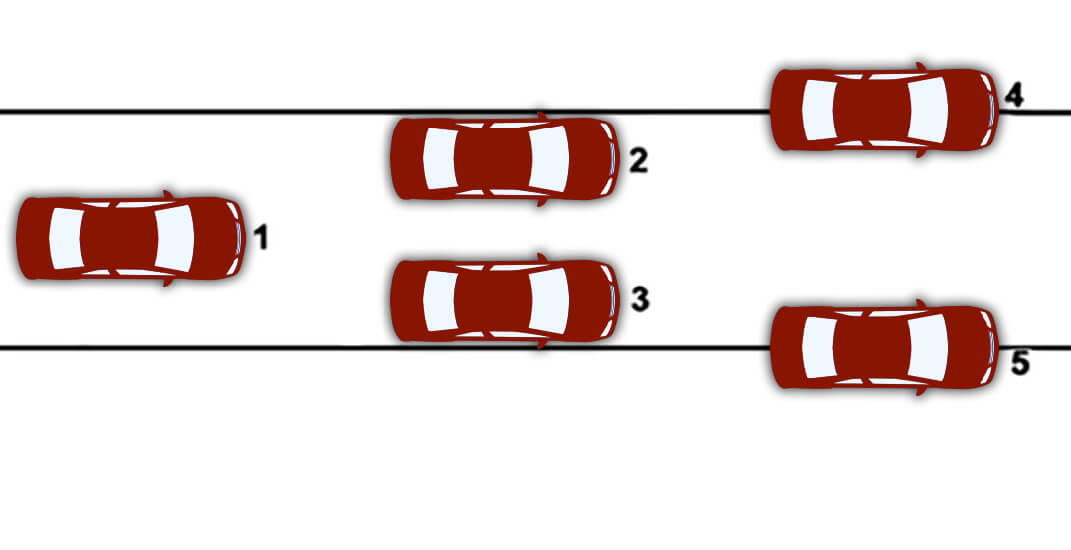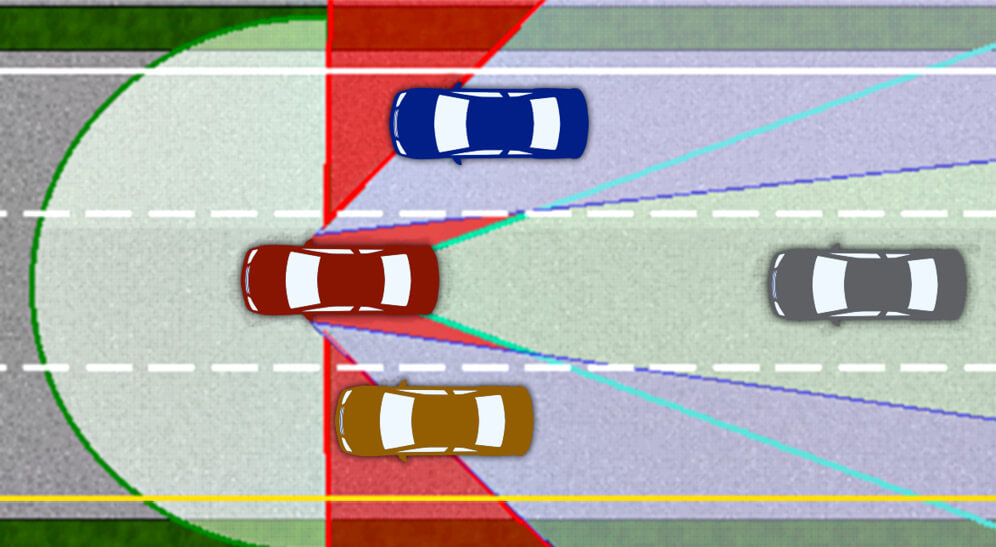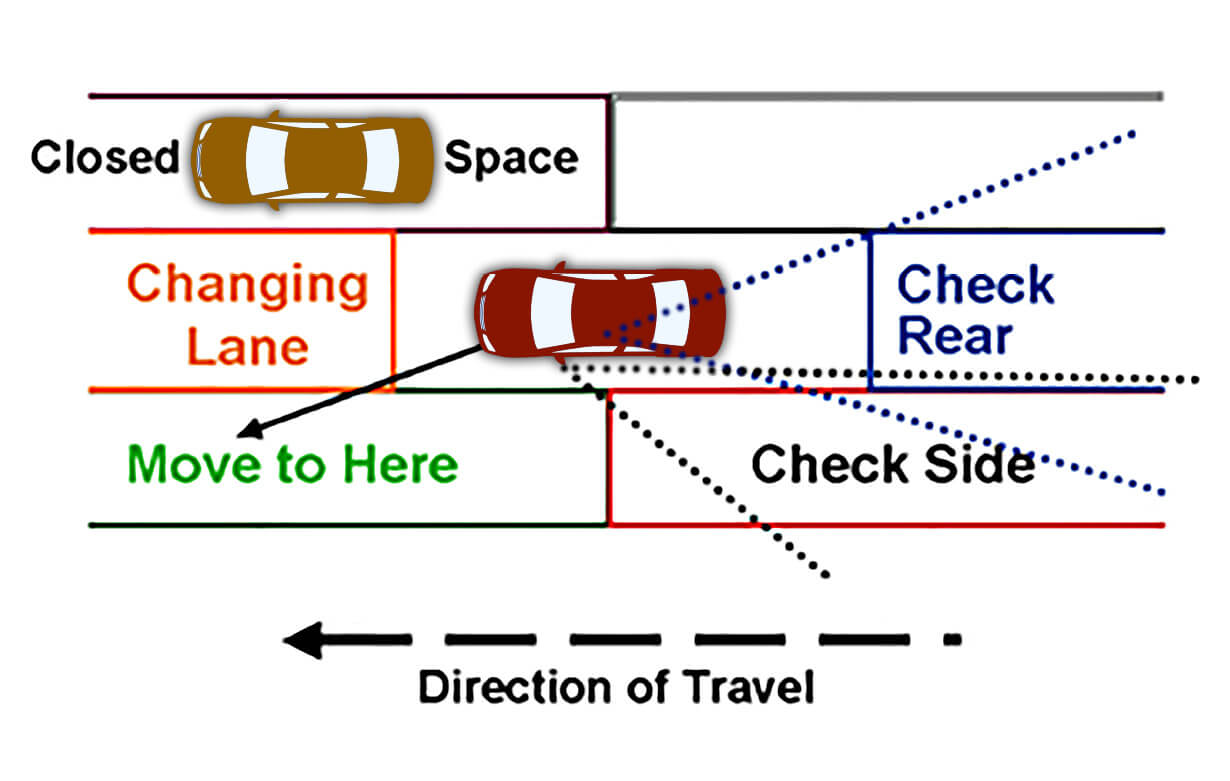Sessions 19-21
Multiple Lane Roadways
Sessions 19-21 focus on lane position, lane changing, following distance, and mirror blind spots. If possible, choose a time when the four-lane roadway on which you select to practice has minimal traffic, such as during early morning hours on Saturday or Sunday.
Lane Position
There are several lane position choices a driver can make without changing lanes. Practice driving in lane position 1, 2 and 3 for several miles during each session.
Position 1: The vehicle is centered in the lane and is the lane position most often used.
Position 2: The vehicle is 6-12 inches from the lane line on the driver’s side, is the lane position for a left turn, and allows for a margin of safety on the right side of the vehicle.
Position 3: The vehicle is 6-12 inches from the passenger side pavement line or curb and is the best position to approach a hill or curve.
Position 4 and 5: The vehicle straddles either lane line due to an obstruction in the path of travel.

Safety Margins
Your most important safety margin, and the one over which you have the most control, is the space in front of the vehicle. Maintaining at least a 3-second space margin from the vehicle ahead provides the driver with visibility, time, and space to avoid frontal crashes, and allows the driver to steer or brake out of danger at moderate speeds. Coach your teen to accelerate or decelerate as the 3-second gap widens or decreases. This will also help the novice driver travel at the speed of the flow of the traffic. When stopping behind another vehicle, coach your teen to stop in a position to see the back tires of the car in front for an adequate space margin.
Mirror Blind Spot
As a bike rider, before making a turn or changing lanes, your teen was taught to check over the shoulder in the area next to and behind the bike to make sure there were no cars. As a driver, coach your teen to monitor the area to the rear with the inside mirror, to the sides with the side view mirrors, and to make a blind spot check in the area slightly beyond the driver’s peripheral field of vision. Coach the driver to look out of the front side windows, not the rear side windows, when checking the mirror blind spot areas. New drivers have a tendency to move the steering wheel in the direction they move their head. Before the head check, coach your teen to focus on not moving the wheel.

Changing Lanes
Changing lanes should not be done too often or unnecessarily. Ask your teen why one would need to change lanes. Answers may include: to avoid an obstacle in your lane; to make a turn; exit the road; park; or to pass another vehicle. Emphasize that passing another vehicle on a two-lane, two-way roadway with limited line of sight is extremely dangerous.
Practice changing lanes 15-20 times during the next three sessions. Lane change steps are:
- check traffic flow to rear and sides for appropriate gap;
- signal intentions by placing gentle pressure on the turn signal lever;
- recheck traffic flow to the rear and sides;
- steady hands and make a quick glance in the mirror blind spot area;
- maintain speed or accelerate slightly before and during the lane change;
- make a gradual move into the lane (front and rear tires should glide almost simultaneously across 3-5 broken pavement lines);
- regain space around the vehicle and adjust following distance as needed.
Right Turns
Right turns are always made from the travel lane closest to the right to the first open lane and end tin the closest open lane.
Left Turns
Left turns can be one of the most hazardous maneuvers your teen will perform. To judge which lane a vehicle is in, tell your teen to look down at the vehicle’s tires in contact with the road, not at the body of the car. When making a left turn from a two-way four-lane street, begin and end the turn in the lane closest to the yellow line. The yellow line should serve as your teen’s target. A protected left turn is one made from a turn lane marked with an arrow, accompanied by a traffic signal arrow. A semiprotected or unprotected left turn is made from a center or shared turn lane or from the through lane. New drivers have difficulty judging the speed and distance of multiple lanes of oncoming traffic. Practice judging oncoming vehicles’ space in seconds.
Passing and Being Passed
Review the legal responsibilities placed on the passing driver and the driver being passed. Using commentary driving, practice the following passing steps with your teen:
- position your vehicle 2-3 seconds behind the vehicle to be passed;
- check mirrors and oncoming traffic;
- check ahead making sure there is plenty of space before you try to pass;
- signal intentions and accelerate quickly to an appropriate speed in the passing lane;
- monitor front and rear space and check the rearview mirror for the front of the car being passed;
- signal intentions; and when you see the front of the car, change lanes, cancel signal, and maintain speed.
NOTE: If someone is trying to pass you, reduce your speed slightly to make it easier. This is not a good time to become competitive!

|
Checklist for Sessions 19-21 |
|
| Place “S” for satisfactory as the following tasks are completed: | |
| Approaches the vehicle with awareness | |
| Enters the vehicle and makes appropriate checks and adjustments | |
| Checks mirrors before slowing or stopping | |
| Maintains a safe following distance at all times | |
| Uses proper signals | |
| Controls speed | |
|
Lane Change |
|
| Checks traffic flow | |
| Signals intentions | |
| Rechecks traffic flow to the rear and sides | |
| Checks blind spots | |
| Maintains speed or accelerates slightly before and during the lane change | |
| Makes a gradual move into the lane (wheels cross 3-5 broken lines) | |
| Avoids hesitation | |
| Checks rearview mirror and identifies the front of car being passed to safely return to lane | |
| Adjusts following distance as needed and regains space around the vehicle | |
|
Vehicle Position |
|
| Selects the best lane and the best lane position | |
| Positions the vehicle three feet from the curb for a right turn | |
| Stops the vehicle with the front bumper even with curb line or behind stop line | |
| Angles wheels slightly to the right when stopped for a right turn | |
| Positions the vehicle 3-6 inches from the center of the road to prepare for a left turn | |
| Maintains at least a 3 second space cushion at all times | |
| Recognizes other vehicles’ “blind areas” | |
| Recognizes and adjusts when being tailgated | |
|
Visual Skills |
|
| Looks well ahead of the vehicle | |
| Looks into the direction of the turns | |
| Selects targets | |
| Recognizes regulatory and warning signs by shape well in advance | |
| Understands the meaning of yellow and white pavement markings | |
| Understands the meaning of solid and broken pavement markings | |
| Searches all corners of the intersection | |
| Selects a target in the center of the path of travel | |
| Judges gap in traffic | |
|
Commentary Driving |
|
| Can explain each position and appropriate reference points | |
| Monitors other highway users | |
| Identifies protected and unprotected intersections | |
